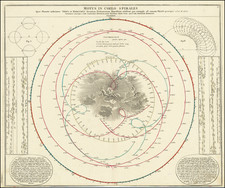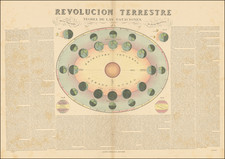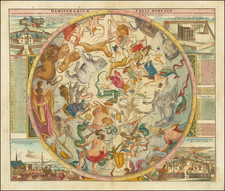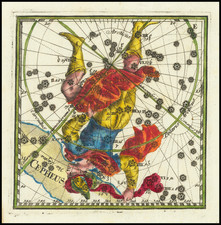A Striking Celestial Polar Hemisphere Projection
Rare double hemisphere celestial map showing a new and more scientific depiction of the heavens, first published circa 1690 by Vincenzo Maria Coronelli in Venice. The present example notes that it is corrected to 1700.
Coronelli's map shows the stars of the northern and southern sky, using a new means for displaying the stars. As noted by Nick Kanas, the map twin hemispheres are
centered on the ecliptic poles using a polar equidistant projection with geocentric orientation. . . . Around the periphery of the plate [is] a prominent dedication to "Marco Bembo" and tables showing stellar magnitudes and positions. . . . Each hemisphere has an equatorial grid superimposed on the ecliptic one, showing that Flamsteed was not the first person to employ a double grid system in a single chart. . . .
The decorative borders include coordinates and descriptions of signs of the zodiac. This example appeared in Coronelli's Corso Geographico.
Rarity
This is the third example of the map we have had in the past 20 years.
Vincenzo Maria Coronelli (1650-1718) was one of the most influential Italian mapmakers and was known especially for his globes and atlases. The son of a tailor, Vincenzo was apprenticed to a xylographer (a wood block engraver) at a young age. At fifteen he became a novice in a Franciscan monastery. At sixteen he published his first book, the first of 140 publications he would write in his lifetime. The order recognized his intellectual ability and saw him educated in Venice and Rome. He earned a doctorate in theology, but also studied astronomy. By the late 1670s, he was working on geography and was commissioned to create a set of globes for the Duke of Parma. These globes were five feet in diameter. The Parma globes led to Coronelli being named theologian to the Duke and receiving a bigger commission, this one from Louis XIV of France. Coronelli moved to Paris for two years to construct the King’s huge globes, which are 12.5 feet in diameter and weigh 2 tons.
The globes for the French King led to a craze for Coronelli’s work and he traveled Europe making globes for the ultra-elite. By 1705, he had returned to Venice. There, he founded the first geographical society, the Accademia Cosmografica degli Argonauti and was named Cosmographer of the Republic of Venice. He died in 1718.












![Globi Coelestis In Tabulas Planas Redacti Pars IV . . . [Virgo, Leo, Hydra, Libra etc.]](https://storage.googleapis.com/raremaps/img/small/70892.jpg)
![[Aquila]](https://storage.googleapis.com/raremaps/img/small/68843.jpg)
